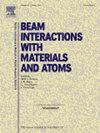A method to detect the VUV photons from cooled 229Th:CaF2 crystals
IF 1.4
3区 物理与天体物理
Q3 INSTRUMENTS & INSTRUMENTATION
Nuclear Instruments & Methods in Physics Research Section B-beam Interactions With Materials and Atoms
Pub Date : 2025-02-18
DOI:10.1016/j.nimb.2025.165647
引用次数: 0
Abstract
Thorium-229, with its exceptionally low-energy nuclear excited state, is the only candidate for developing a nuclear clock. 229Th-doped CaF crystals, benefiting from calcium fluoride’s wide band gap, show great promise as solid-state nuclear clock materials. These crystals are excited by vacuum ultraviolet (VUV) lasers, which over time cause radiation damage. Cooling the crystals can mitigate this damage but introduces a challenge: photoabsorption. This occurs when residual gas molecules condense on the crystal surface, absorbing VUV photons and deteriorating detection efficiency. To solve this, we developed a cooling technique using a copper shield to surround the crystal, acting as a cold trap. This prevents ice-layer formation, even at temperatures below , preserving high VUV photon detection efficiency. Our study detailed the experimental cooling setup and demonstrated the effectiveness of the copper shield in maintaining crystal performance, a critical improvement for future solid-state nuclear clocks operating at cryogenic temperatures.

一种从229:CaF2晶体中探测VUV光子的方法
钍-229具有极低能量的核激发态,是开发核时钟的唯一候选者。229th掺杂的CaF2晶体受益于氟化钙的宽带隙,作为固态核时钟材料显示出很大的前景。这些晶体是由真空紫外线(VUV)激光激发的,随着时间的推移会造成辐射损伤。冷却晶体可以减轻这种损害,但会带来一个挑战:光吸收。当残余气体分子凝结在晶体表面时,就会发生这种情况,吸收VUV光子并降低检测效率。为了解决这个问题,我们开发了一种冷却技术,使用铜屏蔽来包围晶体,作为冷阱。即使在低于- 100°C的温度下,这也可以防止冰层的形成,保持高VUV光子探测效率。我们的研究详细介绍了实验冷却装置,并证明了铜屏蔽在保持晶体性能方面的有效性,这是未来在低温下运行的固态核时钟的关键改进。
本文章由计算机程序翻译,如有差异,请以英文原文为准。
求助全文
约1分钟内获得全文
求助全文
来源期刊
CiteScore
2.80
自引率
7.70%
发文量
231
审稿时长
1.9 months
期刊介绍:
Section B of Nuclear Instruments and Methods in Physics Research covers all aspects of the interaction of energetic beams with atoms, molecules and aggregate forms of matter. This includes ion beam analysis and ion beam modification of materials as well as basic data of importance for these studies. Topics of general interest include: atomic collisions in solids, particle channelling, all aspects of collision cascades, the modification of materials by energetic beams, ion implantation, irradiation - induced changes in materials, the physics and chemistry of beam interactions and the analysis of materials by all forms of energetic radiation. Modification by ion, laser and electron beams for the study of electronic materials, metals, ceramics, insulators, polymers and other important and new materials systems are included. Related studies, such as the application of ion beam analysis to biological, archaeological and geological samples as well as applications to solve problems in planetary science are also welcome. Energetic beams of interest include atomic and molecular ions, neutrons, positrons and muons, plasmas directed at surfaces, electron and photon beams, including laser treated surfaces and studies of solids by photon radiation from rotating anodes, synchrotrons, etc. In addition, the interaction between various forms of radiation and radiation-induced deposition processes are relevant.

 求助内容:
求助内容: 应助结果提醒方式:
应助结果提醒方式:


